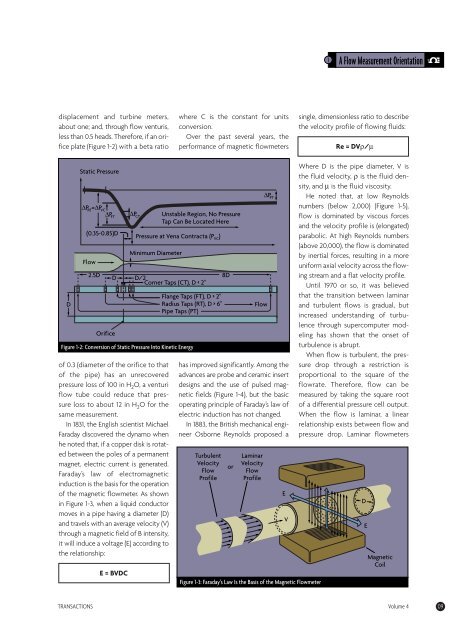flow and level measurement - Omega Engineering
flow and level measurement - Omega Engineering
flow and level measurement - Omega Engineering
Create successful ePaper yourself
Turn your PDF publications into a flip-book with our unique Google optimized e-Paper software.
displacement <strong>and</strong> turbine meters,<br />
about one; <strong>and</strong>, through <strong>flow</strong> venturis,<br />
less than 0.5 heads. Therefore, if an orifice<br />
plate (Figure 1-2) with a beta ratio<br />
D<br />
Static Pressure<br />
ΔP RT =ΔP VC<br />
Flow<br />
ΔP FT<br />
(0.35-0.85)D<br />
Figure 1-2: Conversion of Static Pressure Into Kinetic Energy<br />
of 0.3 (diameter of the orifice to that<br />
of the pipe) has an unrecovered<br />
pressure loss of 100 in H 2 O, a venturi<br />
<strong>flow</strong> tube could reduce that pressure<br />
loss to about 12 in H 2 O for the<br />
same <strong>measurement</strong>.<br />
In 1831, the English scientist Michael<br />
Faraday discovered the dynamo when<br />
he noted that, if a copper disk is rotated<br />
between the poles of a permanent<br />
magnet, electric current is generated.<br />
Faraday’s law of electromagnetic<br />
induction is the basis for the operation<br />
of the magnetic <strong>flow</strong>meter. As shown<br />
in Figure 1-3, when a liquid conductor<br />
moves in a pipe having a diameter (D)<br />
<strong>and</strong> travels with an average velocity (V)<br />
through a magnetic field of B intensity,<br />
it will induce a voltage (E) according to<br />
the relationship:<br />
E = BVDC<br />
ΔP CT<br />
where C is the constant for units<br />
conversion.<br />
Over the past several years, the<br />
performance of magnetic <strong>flow</strong>meters<br />
Unstable Region, No Pressure<br />
Tap Can Be Located Here<br />
Pressure at Vena Contracta (P VC )<br />
Minimum Diameter<br />
2.5D<br />
D D/2<br />
8D<br />
Corner Taps (CT), D ‹ 2"<br />
Orifice<br />
Flange Taps (FT), D › 2"<br />
Radius Taps (RT), D › 6"<br />
Pipe Taps (PT)<br />
has improved significantly. Among the<br />
advances are probe <strong>and</strong> ceramic insert<br />
designs <strong>and</strong> the use of pulsed magnetic<br />
fields (Figure 1-4), but the basic<br />
operating principle of Faraday’s law of<br />
electric induction has not changed.<br />
In 1883, the British mechanical engineer<br />
Osborne Reynolds proposed a<br />
Turbulent<br />
Velocity<br />
Flow<br />
Profile<br />
or<br />
1 A Flow Measurement Orientation<br />
single, dimensionless ratio to describe<br />
the velocity profile of <strong>flow</strong>ing fluids:<br />
Re = DVρ/μ<br />
Where D is the pipe diameter, V is<br />
the fluid velocity, ρ is the fluid density,<br />
<strong>and</strong> μ is the fluid viscosity.<br />
He noted that, at low Reynolds<br />
numbers (below 2,000) (Figure 1-5),<br />
<strong>flow</strong> is dominated by viscous forces<br />
<strong>and</strong> the velocity profile is (elongated)<br />
parabolic. At high Reynolds numbers<br />
(above 20,000), the <strong>flow</strong> is dominated<br />
by inertial forces, resulting in a more<br />
uniform axial velocity across the <strong>flow</strong>ing<br />
stream <strong>and</strong> a flat velocity profile.<br />
Until 1970 or so, it was believed<br />
that the transition between laminar<br />
<strong>and</strong> turbulent <strong>flow</strong>s is gradual, but<br />
increased underst<strong>and</strong>ing of turbulence<br />
through supercomputer modeling<br />
has shown that the onset of<br />
turbulence is abrupt.<br />
When <strong>flow</strong> is turbulent, the pressure<br />
drop through a restriction is<br />
proportional to the square of the<br />
<strong>flow</strong>rate. Therefore, <strong>flow</strong> can be<br />
measured by taking the square root<br />
of a differential pressure cell output.<br />
When the <strong>flow</strong> is laminar, a linear<br />
relationship exists between <strong>flow</strong> <strong>and</strong><br />
pressure drop. Laminar <strong>flow</strong>meters<br />
TRANSACTIONS Volume 4 09<br />
Flow<br />
Laminar<br />
Velocity<br />
Flow<br />
Profile<br />
ΔP PT<br />
Figure 1-3: Faraday's Law Is the Basis of the Magnetic Flowmeter<br />
E<br />
V<br />
D<br />
E<br />
Magnetic<br />
Coil

















